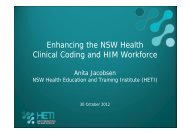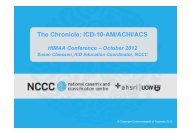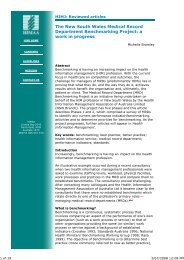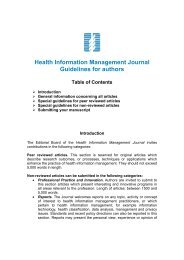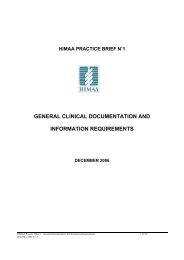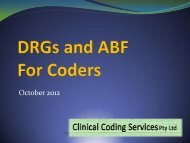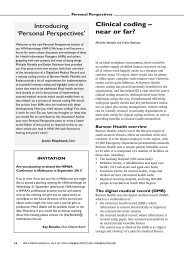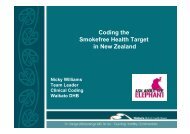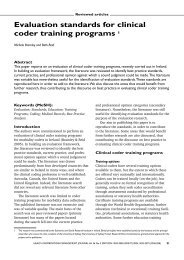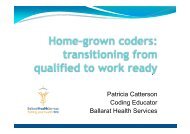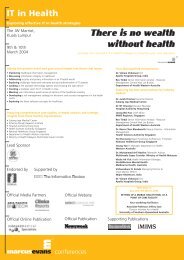A framework for evaluating health classifications - Health Information ...
A framework for evaluating health classifications - Health Information ...
A framework for evaluating health classifications - Health Information ...
You also want an ePaper? Increase the reach of your titles
YUMPU automatically turns print PDFs into web optimized ePapers that Google loves.
Reviewed Articles<br />
• Current Procedural Terminology, fourth edition<br />
(CPT) (USA).<br />
A rating system <strong>for</strong> each criterion was created in<br />
order to make a fair comparison. CPT was the best<br />
per<strong>for</strong>mer, MBS was the worst. The result <strong>for</strong> MBS<br />
was not surprising because it is not a classification,<br />
and it was perhaps unfair to include it in the assessment.<br />
However, the Australian Government saw<br />
merit in developing an Australian procedure classification<br />
based on the MBS, and the rest is history (Innes<br />
et al. 1997). In hindsight, the decision to create an<br />
Australian procedure classification was the best<br />
choice. The OPCS-4 was, and remains, outdated, and<br />
its use in the United Kingdom is under review (National<br />
<strong>Health</strong> Service In<strong>for</strong>mation Authority 2004).<br />
The ICD-10-PCS has not yet been implemented in the<br />
United States, and the future of the CPT is not certain<br />
as debate goes on (and on) about the value of having<br />
only one procedure classification <strong>for</strong> the US 5 (American<br />
Medical Association 1999b; Bowman 2005; Libicki<br />
& Brahmakulum 2004; National Committee on Vital<br />
and <strong>Health</strong> Statistics Subcommittee on Medical Classification<br />
Systems 1993; Rode 2005; Slee 2000).<br />
A study conducted in the Netherlands (Van Achterberg<br />
et al. 2005) transcribed nursing diagnoses to the<br />
International Classification of Functioning, Disability<br />
and <strong>Health</strong> (ICF) to evaluate the fit between that classification<br />
and hospital-based nursing practice. Van<br />
Achterberg et al. (2005) found that the classification<br />
was useful to nursing practice in acute care settings,<br />
and because human functioning is at the heart of<br />
nursing care, they recommended its use in this domain<br />
(p.440). They found that aggregated levels of<br />
the classification were a better match with nursing<br />
diagnoses, than the more detailed levels, and that the<br />
principal focus was on the body functions and activities<br />
components of the classification. Negative points<br />
raised in the study were that some aspects of nursing<br />
observations were found to be missing from the classification.<br />
Nurses also had problems finding terms<br />
because of a lack of familiarity with the structure of<br />
the classification and the language used to describe<br />
the terms. For these reasons, the authors recommended<br />
that nurses participate in future revisions of<br />
the ICF and that the classification be introduced into<br />
nursing curricula (Van Achterberg et al. 2005).<br />
The substantial task of determining a suitable classification<br />
<strong>for</strong> general practice in Australia was undertaken<br />
by the General Practice Coding Jury (2000), and<br />
supported by government funding through the General<br />
Practice Computing Group (GPCG). Bearing in<br />
mind developments in electronic <strong>health</strong> records, the<br />
scope of this evaluation included terminologies as well<br />
as <strong>classifications</strong>. Each criterion was prioritised and<br />
ranked and systems were compared on that basis.<br />
The Jury’s recommendation was to adopt the ICD-10-<br />
AM in the interim (on a 5 year short-term basis), with<br />
a view to ultimately implementing SNOMED-CT, if further<br />
assessments supported such a move (General<br />
Practice Coding Jury 2000: p.4).<br />
5 In the US, two procedure <strong>classifications</strong> are used to code clinical<br />
procedures. ICD-9-CM is used <strong>for</strong> in-patient services. CPT is used in<br />
both ambulatory and in-patient settings. Both systems are used <strong>for</strong><br />
payment (National Committee on Vital and <strong>Health</strong> Statistics Subcommittee<br />
on Medical Classification Systems 1993: pp.8-9).<br />
The Jury’s recommendations were not adopted because<br />
there was no widespread support <strong>for</strong> them<br />
among key stakeholders (General Practice Computing<br />
Group 2002: p.2). One response in particular was a<br />
critique of the methodologies applied by the Jury<br />
(Britt & Miller 2000). The Australian Government<br />
commissioned an independent review to make recommendations<br />
on the best way to proceed. The<br />
GPCG has decided to implement one of those recommendations,<br />
which is to develop a vocabulary <strong>for</strong> general<br />
practice, <strong>for</strong> the areas of diagnosis and problems<br />
(General Practice Computing Group 2002: p.2).<br />
Not all evaluations achieve their goals, as can be<br />
seen in the Jury’s evaluation. It is wise to bear in<br />
mind that evaluations are innately political, primarily<br />
because of the vested interests of various stakeholders<br />
(Leys 2003).<br />
Conclusion<br />
Evaluation is important to evidence-based policy and<br />
practice in <strong>Health</strong> In<strong>for</strong>mation Management. <strong>Health</strong><br />
<strong>classifications</strong> are important components of in<strong>for</strong>mation<br />
systems and should be evaluated. My aim in writing<br />
this paper was to provide a revised and updated<br />
<strong>framework</strong> <strong>for</strong> <strong>evaluating</strong> <strong>health</strong> <strong>classifications</strong> that are<br />
used <strong>for</strong> statistical and reporting purposes. Additional<br />
guidance has been provided, particularly to novices, by<br />
illustrating the criteria with examples from the field,<br />
and using the language of nosology in context to enhance<br />
understanding of these terms. Examples of<br />
evaluation in practice have also been included.<br />
The principles listed in this <strong>framework</strong> are not intended<br />
to be exhaustive, nor will each criterion be<br />
relevant to every evaluation. Rather, these criteria<br />
can be used as building blocks on which to base an<br />
evaluation, because each evaluation will differ in purpose<br />
and objectives. One important point to bear in<br />
mind is that the basic principles on which this <strong>framework</strong><br />
was built will change as <strong>classifications</strong>, and their<br />
relationship with terminologies and in<strong>for</strong>mation technology,<br />
develop over time.<br />
Acknowledgements<br />
I am grateful to Beth Reid and Jean McIntosh <strong>for</strong> providing<br />
useful suggestions to improve this paper. I am<br />
also <strong>for</strong>tunate to have had such a wise mentor in<br />
Rosemary Roberts.<br />
References<br />
American Medical Association (1999a). Current Procedural<br />
Terminology CPT 2000. Illinois, AMA.<br />
American Medical Association (1999b). Issues related to the<br />
use of ICD-10-PCS as the single procedure code set. Available<br />
at: < http://www.ama-assn.org/ama/upload/mm/362/<br />
icd_10_pcs.doc> (accessed 14 June 2005).<br />
American Psychiatric Association (2000). Diagnostic and statistical<br />
manual of mental disorders. Fourth edition. Text revision.<br />
Washington DC, APA.<br />
Answers.com (2005). Definitions <strong>for</strong> granularity. (Webpage of<br />
GuruNet Corporation). Available at:



